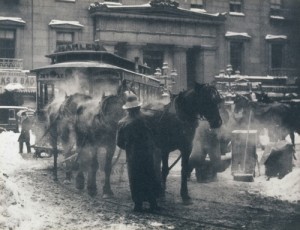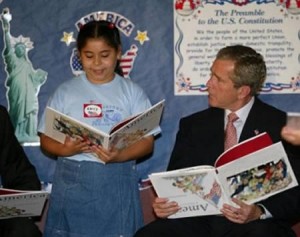Beginning in the 19th century, the medium of photography became one of the principal ways to communicate through images. As many have pointed out, the paradox of photography is that it seems to be a mere representation of what is in the photograph, but it is also always carefully composed and crafted.

In this 1893 photograph, Alfred Stieglitz worked very hard to reproduce the steam because he felt it represented a ‘human touch’ in a lonely urban setting.
In this module we’ll think about photography as a technology and as a medium, taking some time to think and talk about photographs as material objects, and the ways they are produced, reproduced, owned, circulated, shared, saved, archived, or, as in the picture of Pres. Bush and a student, faked.

This photo of George W Bush holding a picture book the wrong way up during a visit to a school delighted some opponents of the Republican president, and helped foster his buffoonish image. But press photos from the event in 2002 revealed that Mr Bush had been holding the book correctly – hoaxers had simply used photo editing software to rotate the cover. http://www.oddee.com/item_96803.aspx
We’ll also talk about meaning and content: how many things can a photograph “say”? What do you need to understand the “meaning” of a photograph? How do those meanings change over time?
Please read the following text:
Susan Sontag, In Plato’s Cave from On Photography (1977)
According to Sontag, how many different things does a photograph do? What kinds of functions does it perform in the making and maintaining of families, groups, and selves? How are changing technologies part of her story? This was written in 1977. How would we update her arguments? Do some of them hold up over time?
Look for a family photograph to bring in to discussion tomorrow. If possible, get to know the story of this photograph: not just what’s in it, but who took it, who saved it, who has seen it, who hasn’t seen it, any details about its material existence.
Take a photograph of “Frenchness”. Use this exercise to think about how representation works, and how photographs create narratives. When thinking about your photograph, try to avoid the clichés: no berets, no baguettes, no flags!
Bring both of these to class tomorrow for our discussion.

8 responses to “#2 On Photography”